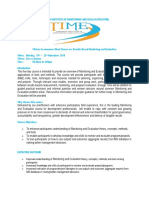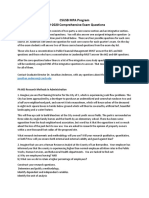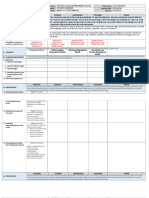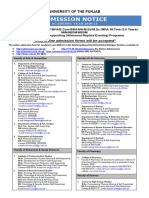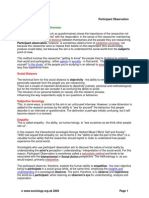Operational And: Strategic Planning
Operational And: Strategic Planning
Uploaded by
Tamseel ShahajahanCopyright:
Available Formats
Operational And: Strategic Planning
Operational And: Strategic Planning
Uploaded by
Tamseel ShahajahanOriginal Description:
Original Title
Copyright
Available Formats
Share this document
Did you find this document useful?
Is this content inappropriate?
Copyright:
Available Formats
Operational And: Strategic Planning
Operational And: Strategic Planning
Uploaded by
Tamseel ShahajahanCopyright:
Available Formats
Operational and
strategic planning
We need to keep operational and strategic planning clearly distinct in our thinking and discussion of
planning in organizations.
Operational and strategic planning are linked decision processes, which should be designed to inform
and support one another for effective management of strategies to improve overall performance of the
organization, whether business or non profit.
At Simply Strategic Planning strategic planning refers to a systematic, formally documented process
for deciding the handful of key decisions that an organization, viewed as a corporate whole, must get
right in order to thrive over the next few years.
In contrast, operational planning or tactical planning is a short-term, highly detailed plan formulated
by management to achieve tactical objectives. Operational or tactical planning involves a systematic
determination and scheduling of the immediate or short-term activities required in achieving the
objectives of strategic planning.
Clearly the time horizon of the decisions involved is a key difference between operational and strategic
planning. However, the difference between operational and strategic planning is more than a matter of
short or long term planning horizon.
Operational and strategic planning differ according to the decisions involved
In my view the number, scope and time span of the decisions involved are at the heart of the definition of
strategic planning. Operational and strategic planning are distinguished primarily by the number, kind and
time span of the decisions involved, as summarized in this table.
If you see something that purports to be a strategic plan, and it has a list of 40 objectives for only one
year with no overall corporate performance indicator to guide evaluation of the overall implementation
of the plan you are not looking at a corporate strategic plan, and it is probably some kind of
operational plan.
You can think of a strategic plan as a written long-range plan, which is founded on an enduring
corporate purpose, and including a small set of corporate strategic objectives. A corporate strategic
plan includes brief statements of a handful of strategies indicating how to achieve the corporate
strategic priorities. Strategic planning also provides the indicators for assessing and controlling
performance of the organization as a corporate whole.
We define operational planning, on the other hand, as the setting of short-term objectives for specific
functional areas such as finance, marketing, and human resources. Performance is monitored and
controlled using management performance indicators (MPI) or Key Performance Indicators (KPI)
rather than Corporate Performance Indicators (CPI) or Beneficiary Performance Indicators (BPI). This
latter is a tool unique in the Argenti Strategic Planning Process.
Strategic plans tend to be more general, and have longer time horizons than do operational plans.
Strategic plans normally cover a three-to-five-year and longer planning horizons, while most
operational plans usually cover periods of something less than a year. Operational and tactical plans
are more concrete and expressed in practical day-to-day terms. Operational plans might include
written manufacturing capacity plans, inventory, and sales forecasts; and financial, human resource,
and advertising budgets, for monthly or quarterly periods.
Operational and strategic planning are linked
Despite the clear distinctions we are making it is also important to understand that operational and
strategic planning are interrelated and complementary decision processes, which must link to each
other, inform and support one another for effective management of strategies.
Operational planning is the day-by-day, week-by-week, and month-by-month planning for a myriad of
local and functional activities; strategic planning sets the overall direction of your organisation as a
whole, its destiny if you will. The decisions that constitute the strategic plan include what the
enterprise is not currently doing, but should be doing. The choices of what to do imply other things
that the organization deliberately chooses not do. The strategic plan embodies very big decisions with
major consequences for the overall performance.
Strategic and tactical planning are different in kind. The two forms of planning must be linked, and
integrated, and must not be confused.
Avoid confusion between operational and strategic planning
Summarizing - strategic planning is not a lot of things it is often confused with:
It is not marketing, product planning, market research, marketing strategy, business model
designing, IT strategy, or planning for any other particular part or function.
It is not long-range planning, business planning or budgeting.
It is not forecasting.
It is not finance planning, cash flow planning, human resources planning, production planning,
project planning
It is neither co-coordinating nor operational planning.
It is neither sophisticated nor advanced. It is essentially simple. However, that does not mean is it
easy!
Regrettably, I believe that much of the usual commentary on operational and strategic planning falls
into one or more of these unhelpful answers to the question what is strategic planning? They are
misconceptions, and they sometimes arise from a deliberate tactic by academics, writers and
consultants in this field people like me, in other words! Our problem is that, correctly defined and
properly practiced, corporate strategic planning is an embarrassingly small subject area. In practice, a
strategic plan, crucially important though it is, is a modest document of just a few pages. It is easy to
see why academics and consultants need to expand the definition of corporate strategic planning in
their books and assignments. They need to throw in anything remotely relevant, such as business
planning, marketing and product development, strategic management, portfolio analysis, research into
new markets, financial planning and raising capital, acquisitions and mergers planning, action plans,
restructuring the management, managing the research function.
Many of these may need to come at the end of the corporate strategic planning process. This is how
the strategic plan gets translated into action. Operational planning and strategic planning link in this
practical fashion; to include them both into a definition of strategic planning is quite misleading.
Operational and strategic planning are linked as a guide to action which flows from a way of thinking.
The key elements of the strategic plan should govern the behavior of everybody responsible for
operational planning. It enables organisations to think through and document what they are doing, for
whom they are doing it, and why.
Operational and strategic planning contrasted
A corporate strategic plan, then, consists of a very few but momentous statements about the long-term
future of the organization as a whole.
'We will merge with a competitor' is a message of the utmost simplicity but of huge importance for any
business - if they do merge life will never be the same again. Notice the stark simplicity of this statement;
contrast its half-dozen words with, say, a hundred-page report on a new product.
Contrast it, too, with the alternative: 'We will not merge.' Surprisingly often the issue in corporate planning
seems to boil down to deciding between diametrically opposite strategic directions. A parting of the ways;
the company at a crossroads; the horns of a dilemma; reassessment of its roots; diversify or, on the
contrary, trim back to the core; cut manufacturing costs or, on the contrary, increase them to add value;
gain share in the home market or, on the contrary, go for exports; go public or stay private.
You may be surprised how bluntly these choices can be presented to managements when they really get
down to fundamentals. Issues that executives used to fight over, sometimes for years, problems that have
been examined by committee after committee, pale into insignificance when the real strategic problems -
the truly elephant sized corporate issues - are finally identified, simply and starkly. The focus of the top
managers' thinking switches abruptly into the true area of concern.
Every company of every size and type occasionally has to make a big decision, the sort of decision that
affects its entire destiny for years or even decades into the future, decisions which change not just parts or
departments or sections of the company but which alter its whole structure and the very nature of the
company itself. They are the sort of decisions that the company and its employees will look back on in years
to come and say, 'that was the year when
By contrast, operational planning may involve many detailed calculations. Working out the capacity
needed to produce a new line of products using materials different to ones previously employed, with
the associated transport, storage and other logistics implications can be a very large complex and
taxing effort.
However, we hope that the decision to go with this new line of products has been taken at the right
level where its organization wide implications could be assessed. That is the job of the strategic
planning process.
To find out more about the unique features of strategic planning look at theArgenti Process.
Go back from Operational and Strategic Planning to Definition of Strategic Planning.
Go to Simply Strategic Planning Home Page.
You might also like
- PDFDocument5 pagesPDFFabio Taveiro100% (1)
- Sds 101 Stand-Up Project - Group 2Document19 pagesSds 101 Stand-Up Project - Group 2Jeydrew TVNo ratings yet
- Adnan Gazette FileDocument52 pagesAdnan Gazette FileTamseel ShahajahanNo ratings yet
- List of Pharma Companies in MumbaiDocument43 pagesList of Pharma Companies in MumbaiTamseel Shahajahan50% (2)
- GMP GHP SopDocument64 pagesGMP GHP SopPrasad MgNo ratings yet
- PA 214 Updated Approaches To ManagementDocument187 pagesPA 214 Updated Approaches To ManagementAli HasanieNo ratings yet
- Management Control SystemsDocument3 pagesManagement Control Systemsshanti priyaNo ratings yet
- Cybernetic GovernanceDocument3 pagesCybernetic Governancesuhajanan16No ratings yet
- Course Title - Public Policy AnalysisDocument116 pagesCourse Title - Public Policy AnalysisKdropsNo ratings yet
- Management Theories and PracticesDocument4 pagesManagement Theories and PracticesZelalem JemberuNo ratings yet
- Module 1 - Introduction To Human Resource ManagementDocument20 pagesModule 1 - Introduction To Human Resource ManagementSonam AgarwalNo ratings yet
- Management Control System: SyllabusDocument6 pagesManagement Control System: SyllabusAnnisa Ayu DewantiNo ratings yet
- Management Principles and Techniques-1Document43 pagesManagement Principles and Techniques-1titoNo ratings yet
- GST202 Fundamentals of Peace Studies and Conflict SummaryDocument21 pagesGST202 Fundamentals of Peace Studies and Conflict Summarym2kxcg4gsxNo ratings yet
- Publishing Your ResearchDocument41 pagesPublishing Your ResearchSyed Fawad MarwatNo ratings yet
- Management Control Systems in Public AdministrationDocument18 pagesManagement Control Systems in Public AdministrationNayana Makwana100% (1)
- Publishing in International JournalsDocument36 pagesPublishing in International JournalsCarlo MagnoNo ratings yet
- Public Policy SyllabusDocument6 pagesPublic Policy Syllabusmhickey babonNo ratings yet
- Politics of Development and Underdevelopment Syllabus CPO 4034Document16 pagesPolitics of Development and Underdevelopment Syllabus CPO 4034Michelle MunroeNo ratings yet
- Political Development - ConceptDocument4 pagesPolitical Development - ConceptKotha SarkerNo ratings yet
- Politics of DevelopmentDocument2 pagesPolitics of DevelopmentAngelika May Santos Magtibay-VillapandoNo ratings yet
- Control TechniquesDocument37 pagesControl TechniquesAmit ShahNo ratings yet
- Pa 212 Planning and Control Management Course OutlineDocument1 pagePa 212 Planning and Control Management Course OutlineNormina ManialaNo ratings yet
- Politics and DevelopmentDocument103 pagesPolitics and DevelopmentMark Goeffrey Soguilon GustiloNo ratings yet
- Peace Education 1st TopicDocument16 pagesPeace Education 1st Topicsoylou mesiasNo ratings yet
- Strategic Planning Primer Higher EducDocument30 pagesStrategic Planning Primer Higher EducJrleanne Donatha100% (1)
- 04 Planning Process, Strategic Planning and Operational Planning.Document22 pages04 Planning Process, Strategic Planning and Operational Planning.ravi anandNo ratings yet
- Role of The GovernmentDocument7 pagesRole of The GovernmentAmbalika SmitiNo ratings yet
- Introduction To Human Behavior in OrganizationDocument47 pagesIntroduction To Human Behavior in OrganizationJelaine Mangin-SamontinaNo ratings yet
- HRM ModuleDocument92 pagesHRM ModuleShyam Khamniwala100% (1)
- Public Policy PPT To Be SharedDocument116 pagesPublic Policy PPT To Be SharedAmen FrewNo ratings yet
- Principles of Management 1: Foundations of Planning Lecturer: Dr. Mazen Rohmi Department: Business AdministrationDocument30 pagesPrinciples of Management 1: Foundations of Planning Lecturer: Dr. Mazen Rohmi Department: Business Administrationhasan jabrNo ratings yet
- Voluntary Sector Management 01.15.24Document16 pagesVoluntary Sector Management 01.15.24Guinto, AngeloNo ratings yet
- Module Design For Policy AnalysisDocument2 pagesModule Design For Policy AnalysisaltlawforumNo ratings yet
- Research Methodology: The Research Process: A Quick GlanceDocument29 pagesResearch Methodology: The Research Process: A Quick GlanceAB Pasha100% (1)
- Introduction To Leadership IDocument17 pagesIntroduction To Leadership IOmri100% (1)
- Anti-Corruption in Public Procurement inDocument32 pagesAnti-Corruption in Public Procurement inYustina Lita Sari100% (1)
- Questions Theory FinalDocument7 pagesQuestions Theory FinalMair Angelie BausinNo ratings yet
- New Public Management: Ethel N. Mendiola Ulysses Quinton Dada VillanuevaDocument21 pagesNew Public Management: Ethel N. Mendiola Ulysses Quinton Dada VillanuevadspyNo ratings yet
- Results Based Monitoring and Evaluation 20181029 FinalDocument2 pagesResults Based Monitoring and Evaluation 20181029 FinalOthman MichuziNo ratings yet
- Politics of Development NotesDocument8 pagesPolitics of Development NotesThabani MoyoNo ratings yet
- Syllabus Org MGT Mapa16-17Document10 pagesSyllabus Org MGT Mapa16-17Mariecris Barayuga Duldulao-AbelaNo ratings yet
- SYLLABUS Principles of TeachingDocument26 pagesSYLLABUS Principles of TeachinghelenaNo ratings yet
- Feasibility StudyDocument9 pagesFeasibility Studyomobolaji GbadegaNo ratings yet
- Nature of LeadershipDocument21 pagesNature of LeadershipArk MusicNo ratings yet
- Strategic Management and Strategic LeadershipDocument5 pagesStrategic Management and Strategic LeadershipYohannesaregawiNo ratings yet
- Strategic Planning SyllabusDocument3 pagesStrategic Planning Syllabusnikub58No ratings yet
- Strategic and Operational Planning: Ip Ceit Inictel-UniDocument34 pagesStrategic and Operational Planning: Ip Ceit Inictel-UniHugo Alonzo RamírezNo ratings yet
- Lecture 2 - Policy Analysis and Policy MakingDocument15 pagesLecture 2 - Policy Analysis and Policy MakingJayOnesKamangaNo ratings yet
- Soderberg Kovacs Hoglund & Jimenez 2021Document15 pagesSoderberg Kovacs Hoglund & Jimenez 2021Nick TobiaNo ratings yet
- Design of Individual PositionsDocument12 pagesDesign of Individual PositionsPhoeza Espinosa VillanuevaNo ratings yet
- 2022 MMDA Operations ManualDocument1,192 pages2022 MMDA Operations ManualdreigalaxyworkNo ratings yet
- Qualities of A Good Leader - Lesson 1 - SHEDocument11 pagesQualities of A Good Leader - Lesson 1 - SHEaliza khanNo ratings yet
- Organisation Culture and Diversity Lecture 3Document13 pagesOrganisation Culture and Diversity Lecture 3rch_ngNo ratings yet
- The Environment & Development: - Nicholas Stern, The Stern Review On The Economics of ClimateDocument19 pagesThe Environment & Development: - Nicholas Stern, The Stern Review On The Economics of ClimateErikaNicoleDumoranGumilinNo ratings yet
- 2019-20 Cmprehensive Exam Question Pool - 0 - 0Document7 pages2019-20 Cmprehensive Exam Question Pool - 0 - 0sheng cruzNo ratings yet
- Chapter II Project DevDocument41 pagesChapter II Project DevMSWDONo ratings yet
- Business EnvironmentDocument23 pagesBusiness EnvironmentAlbert Gevero FalsarioNo ratings yet
- BSA3B - Activity - GAD LawsDocument3 pagesBSA3B - Activity - GAD LawsPhebe LagutaoNo ratings yet
- Strategic Management in Public AdministrationDocument27 pagesStrategic Management in Public AdministrationAida LianaNo ratings yet
- Organization TheoryDocument11 pagesOrganization TheoryAnas TariqNo ratings yet
- Definition of Strategic PlanningDocument4 pagesDefinition of Strategic PlanningAmr Shabana100% (1)
- Shanu Return Ticket To Sobani HostelDocument1 pageShanu Return Ticket To Sobani HostelTamseel ShahajahanNo ratings yet
- Doordarshan Swot AnalysisDocument2 pagesDoordarshan Swot AnalysisTamseel ShahajahanNo ratings yet
- CSR KajalDocument145 pagesCSR KajalTamseel ShahajahanNo ratings yet
- Allana Institute of Management Studies (Aiaims) : CertificateDocument1 pageAllana Institute of Management Studies (Aiaims) : CertificateTamseel ShahajahanNo ratings yet
- SEM IV Final Project DetailsDocument10 pagesSEM IV Final Project DetailsTamseel ShahajahanNo ratings yet
- Capital BudgetingDocument3 pagesCapital BudgetingTamseel ShahajahanNo ratings yet
- Excel Imp FormulasDocument7 pagesExcel Imp FormulasTamseel ShahajahanNo ratings yet
- Mms Iii Sem Year 2014-2015 Specialization Room No: Timing Monday Tuesday Wednesday Thursday Friday Saturday Sunday DateDocument6 pagesMms Iii Sem Year 2014-2015 Specialization Room No: Timing Monday Tuesday Wednesday Thursday Friday Saturday Sunday DateTamseel ShahajahanNo ratings yet
- Irctcs E-Ticketing Service Electronic Reservation Slip (Personal User)Document1 pageIrctcs E-Ticketing Service Electronic Reservation Slip (Personal User)yash77111No ratings yet
- Specifications Sheet Industrial Accelerometer A0322lc Ams en 39608 PDFDocument2 pagesSpecifications Sheet Industrial Accelerometer A0322lc Ams en 39608 PDFRICARDO ALEXIS LARA GALLEGONo ratings yet
- Furuno Fa - 30 Operator Manual PDFDocument33 pagesFuruno Fa - 30 Operator Manual PDFZaw Khaing WinNo ratings yet
- Lecture Summary 1Document2 pagesLecture Summary 1Arnan LizardoNo ratings yet
- Litro Gas Turning A Profit After Years - ChairmanDocument8 pagesLitro Gas Turning A Profit After Years - ChairmanjonathanshahNo ratings yet
- Energy Conscious Architecture - 2Document57 pagesEnergy Conscious Architecture - 2Abhishek Das100% (1)
- 2011 A Typology of Prison OfficerDocument15 pages2011 A Typology of Prison OfficerMaria Constanza Busquets BorgheresiNo ratings yet
- A) Surface Test EquipmentsDocument122 pagesA) Surface Test EquipmentsSaad TiganiNo ratings yet
- Biological Basis of Behavior - Lect 1Document19 pagesBiological Basis of Behavior - Lect 1bilalNo ratings yet
- Usr WWW Users Melita Safe24.md Image PDF Dsc-Powerseries-ChartasDocument1 pageUsr WWW Users Melita Safe24.md Image PDF Dsc-Powerseries-ChartasTehno PRO Supraveghere video MoldovaNo ratings yet
- HBSE - Personality Theories Part 1Document31 pagesHBSE - Personality Theories Part 1Daisy Palero TibayanNo ratings yet
- RD ST ND RDDocument2 pagesRD ST ND RD1 - NICDAO MARY JULIENNENo ratings yet
- Weekly Home Learning Plan For Grade 7: Department of EducationDocument4 pagesWeekly Home Learning Plan For Grade 7: Department of EducationJan IcejimenezNo ratings yet
- BLOKSET Technical GuideDocument189 pagesBLOKSET Technical GuideHANIF AKBAR100% (2)
- Novi Projekti EP HZHB Za 2009Document62 pagesNovi Projekti EP HZHB Za 2009Namik HadziibrahimovicNo ratings yet
- Sentence SubjectsDocument3 pagesSentence SubjectsClaudia MicuNo ratings yet
- 08-Revision Sailing CalculationsDocument139 pages08-Revision Sailing CalculationsSapna DasNo ratings yet
- ClassificationDocument69 pagesClassificationada sdgsdNo ratings yet
- UntitledDocument2 pagesUntitledjessica lorcaNo ratings yet
- The Gemba WalkDocument27 pagesThe Gemba Walkrachid abouriNo ratings yet
- Grade 7 Daily Lesson Log Monday Tuesday Wednesday Thursday FridayDocument5 pagesGrade 7 Daily Lesson Log Monday Tuesday Wednesday Thursday FridaydxoxnxgNo ratings yet
- CHE10209 Couplings Seals BearingsDocument36 pagesCHE10209 Couplings Seals BearingsFA AyNo ratings yet
- xp15 ManualDocument4 pagesxp15 ManualMustafa PatanNo ratings yet
- Industrial Training ReportDocument4 pagesIndustrial Training ReportMohd Shahrizan100% (1)
- Formal InvitationDocument15 pagesFormal Invitationjhon0% (1)
- 2019 Winter Model Answer Paper (Msbte Study Resources) 2022-06-01T191325.048Document19 pages2019 Winter Model Answer Paper (Msbte Study Resources) 2022-06-01T191325.048EE5IRS Roll.34 Prem gaheraoNo ratings yet
- Combined AdvertisementDocument6 pagesCombined Advertisementstubornguy3No ratings yet
- Opengl: - State Machine: Implicit Global VariablesDocument11 pagesOpengl: - State Machine: Implicit Global VariablesSmita SajjanNo ratings yet
- Participant ObservationDocument17 pagesParticipant ObservationindecorumNo ratings yet
- Genetic Engineering: By: Faiza Rashid Lecturer City University of Science and Information Technology, Peshawar, PakistanDocument19 pagesGenetic Engineering: By: Faiza Rashid Lecturer City University of Science and Information Technology, Peshawar, PakistanFaiza RashidNo ratings yet








































